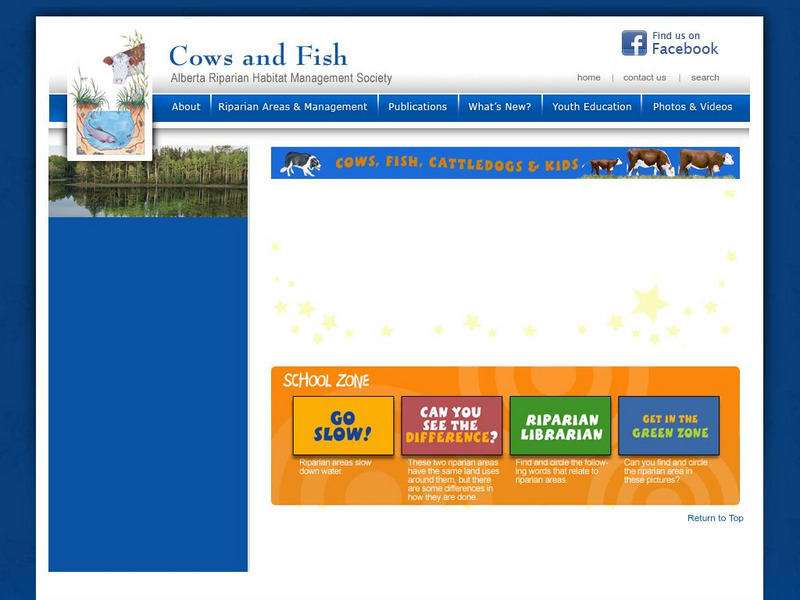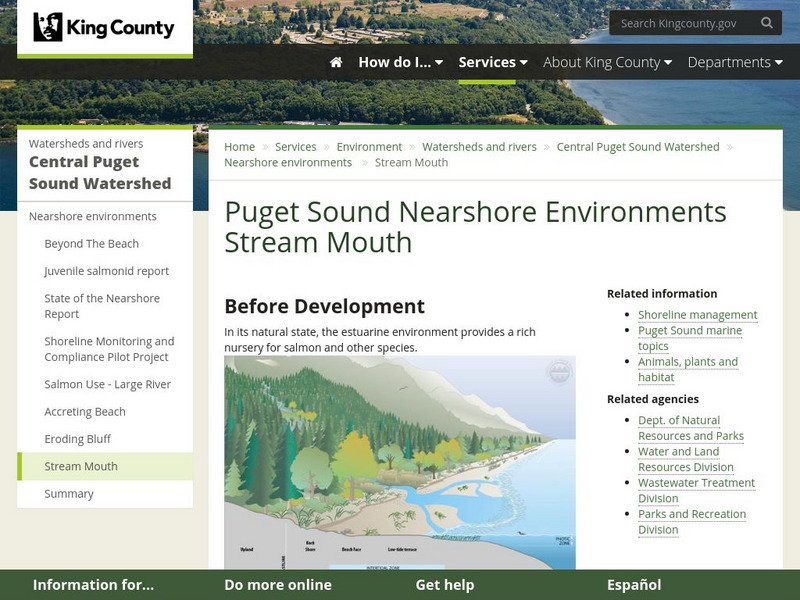Other
Cwec: Down the Hill . . . Your Watershed (Mini Unit) [Pdf]
Everyone is part of a local watershed and their actions affect the water resources in their watershed. In this mini-unit, students learn about watersheds, why they are important, dangers they face and how watersheds can be protected.
Other
Watershed Atlas: What's a Watershed?
A comprehensive definition and illustrations of what watersheds are and why they are important. Understand how watersheds form and the habitats produced by them.
Other
Alberta Riparian Habitat Management Society: Cows, Fish, Cattledogs and Kids!
Children will learn about riparian areas and their importance in maintaining balanced ecosystems in lands adjoining lakes, streams and rivers, as they play these colourful, interactive games.
US Geological Survey
Lake Pontchartrain Basin Foundation: Watershed
Explore the characteristics of a watershed through these multiple intelligences learning activities. Activities will help students define a watershed as well as read the features on a topographic map. Site also includes background...
Other
Virtual Courseware Project: Geology Labs on Line: Virtual River
Learn about river processes like discharge, flooding, flood frequency, erosion, and deposition in this interactive tutorial. Tutorial includes interactive exercises and assessments.
US Environmental Protection Agency
Epa: Surf Your Watershed
This resource provides information on watersheds, maps, activities, and links to local watershed information.
Other
Center for Watershed Protection
Explore this non-profit organizations site for watershed information.
Science Education Resource Center at Carleton College
Serc: Lab 2: What's a Watershed?
Learners build a physical model to simulate watershed features, then use Google Earth software to tie the model to a real place. By exploring several layers of map-based images and data, students learn the complexity of a watershed and...
Texas Education Agency
Texas Gateway: Human Activity in Watersheds
Given scenarios, descriptions, maps and illustrations, students will be able to model the effects of human activity on groundwater and surface water in a watershed.
Other
Pennsylvania Department of Environmental Protection: Just for Kids: Watershed
What is a watershed? Learn the answer to this question and find out about the Susquehanna River watershed on this site.
NOAA
Noaa: Freshwater
This site is designed to assist the educator in teaching concepts and processes related to freshwater environments and to increase stewardship of these important resources. There are links to resources regarding the Great Lakes...
Morning Earth
We All Belong: Biosphere as Place: Biomes and Watersheds
Students examine the Biology topic of the biosphere. The tutorial includes definitions, examples, and pictures on biomes and watersheds.
American Geosciences Institute
American Geosciences Institute: Earth Science Week: Identifying Your Watershed
Learners identify the watershed they live in and study the pathway of surface runoff which ultimately becomes the source of water used at home,
American Geosciences Institute
American Geosciences Institute: Earth Science Week: Splish Splash
Students conduct a large-group brainstorming session on the various places where liquid water can be found on Earth. Then they create a list of places, such as oceans, lakes, rivers, aquifers and trace the path the water travels.
University of Oregon
Streams and Stream Dynamics/evolution of Drainage System
Drainage basis and drainage patterns, in addition to the three stages of stream development(youthful, mature, old age).
Science Education Resource Center at Carleton College
Serc: Mn Step: Watersheds Urban and Rural
In this activity students build models of two types of watersheds, one urban and one rural. They will then simulate rain or the water cycle and observe what happens to the 'soil.' This activity leads to discussions about the water cycle,...
PBS
Pbs Teachers: Water Use: Tragedy in the Owens River Valley
Map the geographical area of a watershed, evaluate watershed use and describe land use practices of the people within one. Investigate the events surrounding the war over the Owens River in California at the turn of the 20th century.
US Geological Survey
Usgs: Edna Derived Watersheds for Major Named Rivers
A watershed index where students can click on a map of the U.S. to find the names and locations of watersheds. Students can also download a file that can be run in Google Earth to view more about the watershed.
Other
Puget Sound Nearshore Environments Stream Mouth
Information specific to developing near streams and the damage it can cause to these bodies of water.
American Geosciences Institute
American Geosciences Institute: How Is Water Distributed?
See how the topography and gravity affect the distribution and flow of Earth's water.
EL Education
El Education: A Child's Guide to Riverhill Farm
This is a child's guide or manual designed for Riverhill Farm. These 3rd and 4th grade students were studying about watersheds and farming; they visited the farm several times and learned various aspects of farming. The guide includes an...
CNN
Cnn: Annan: Mozambique Floods Wash Away Economic Gains
This article discusses flooding that took place in Mozambique during March of 2000.


![Cwec: Down the Hill . . . Your Watershed (Mini Unit) [Pdf] Lesson Plan Cwec: Down the Hill . . . Your Watershed (Mini Unit) [Pdf] Lesson Plan](https://d15y2dacu3jp90.cloudfront.net/images/attachment_defaults/resource/large/FPO-knovation.png)


















